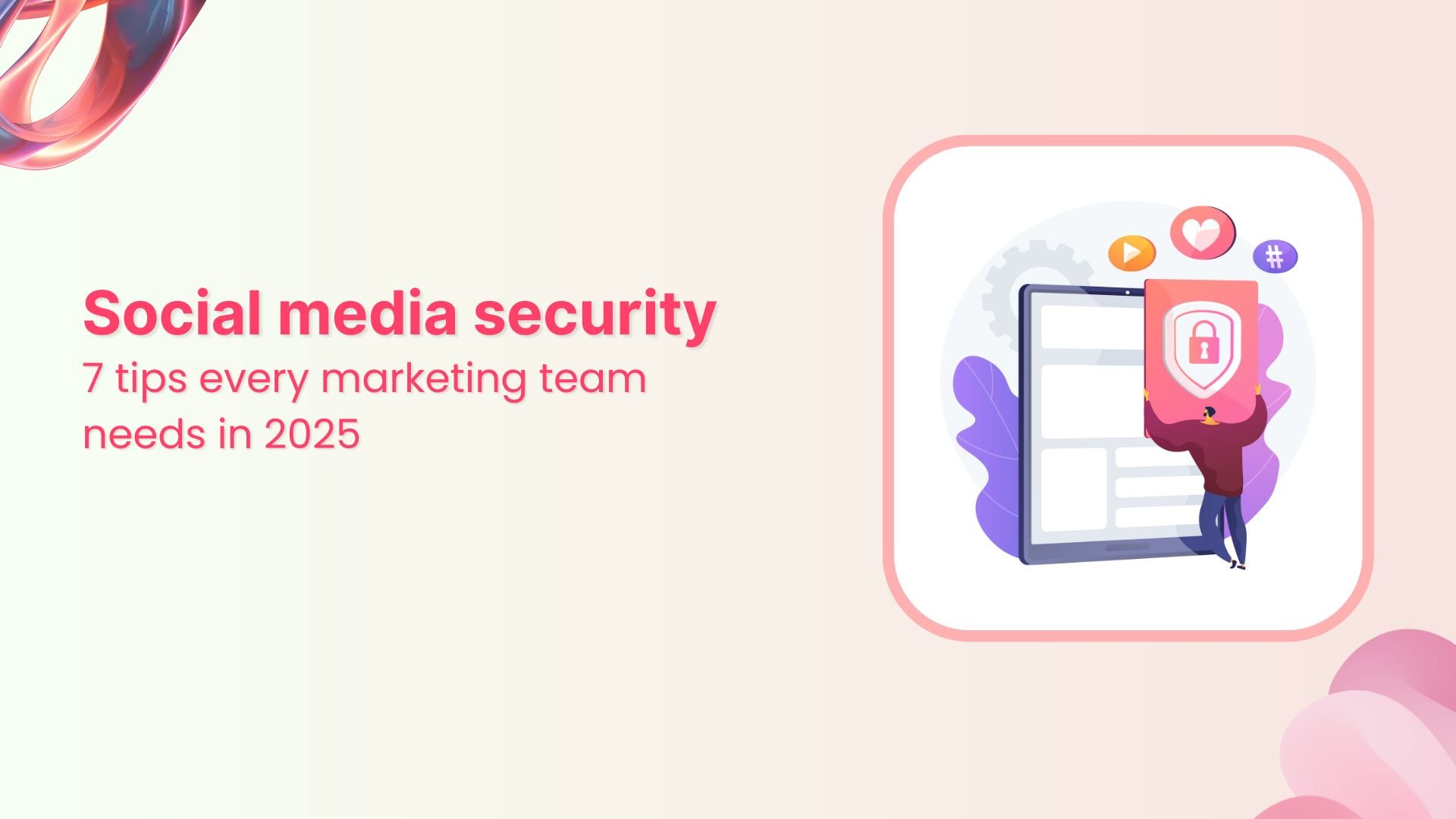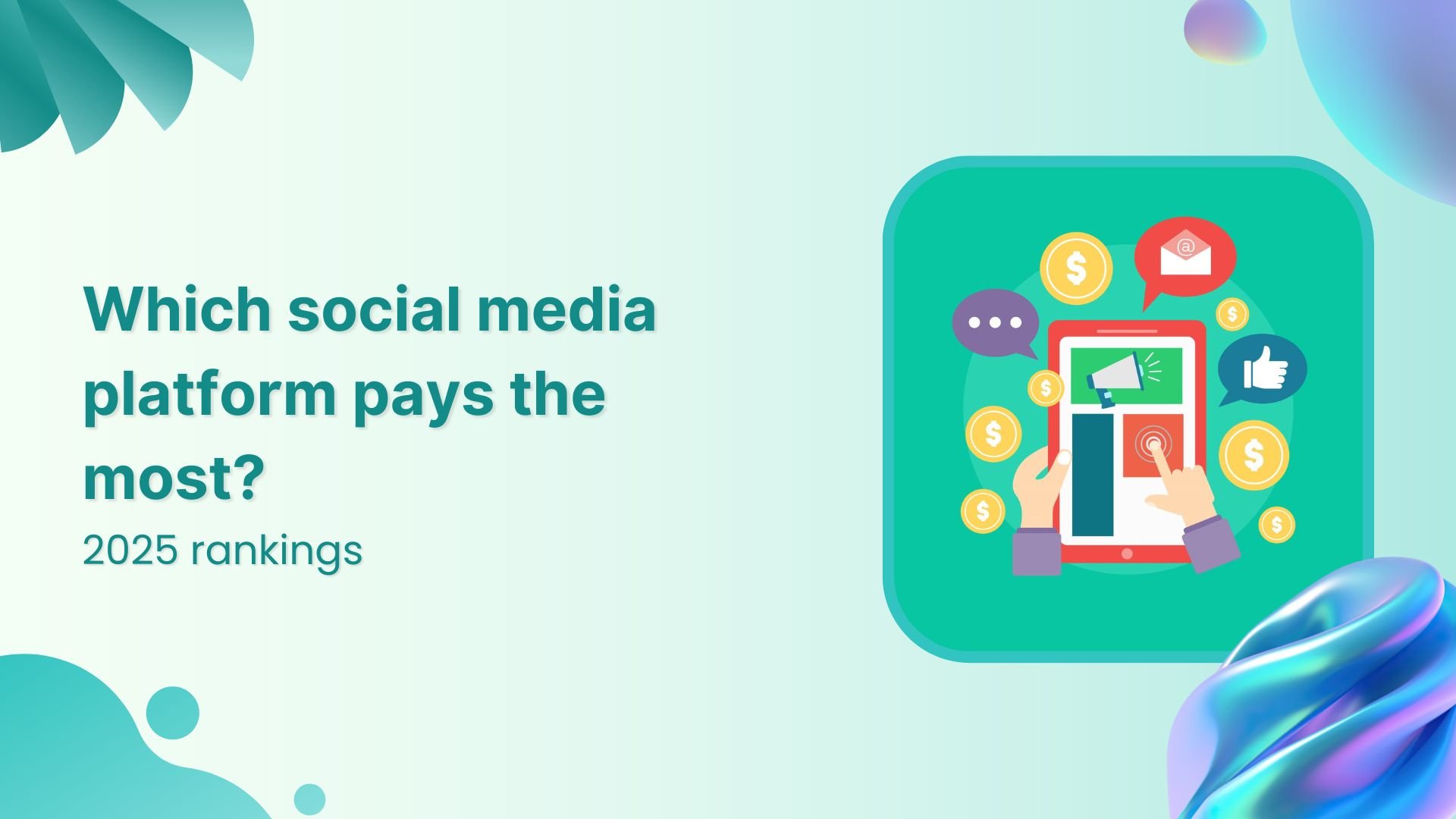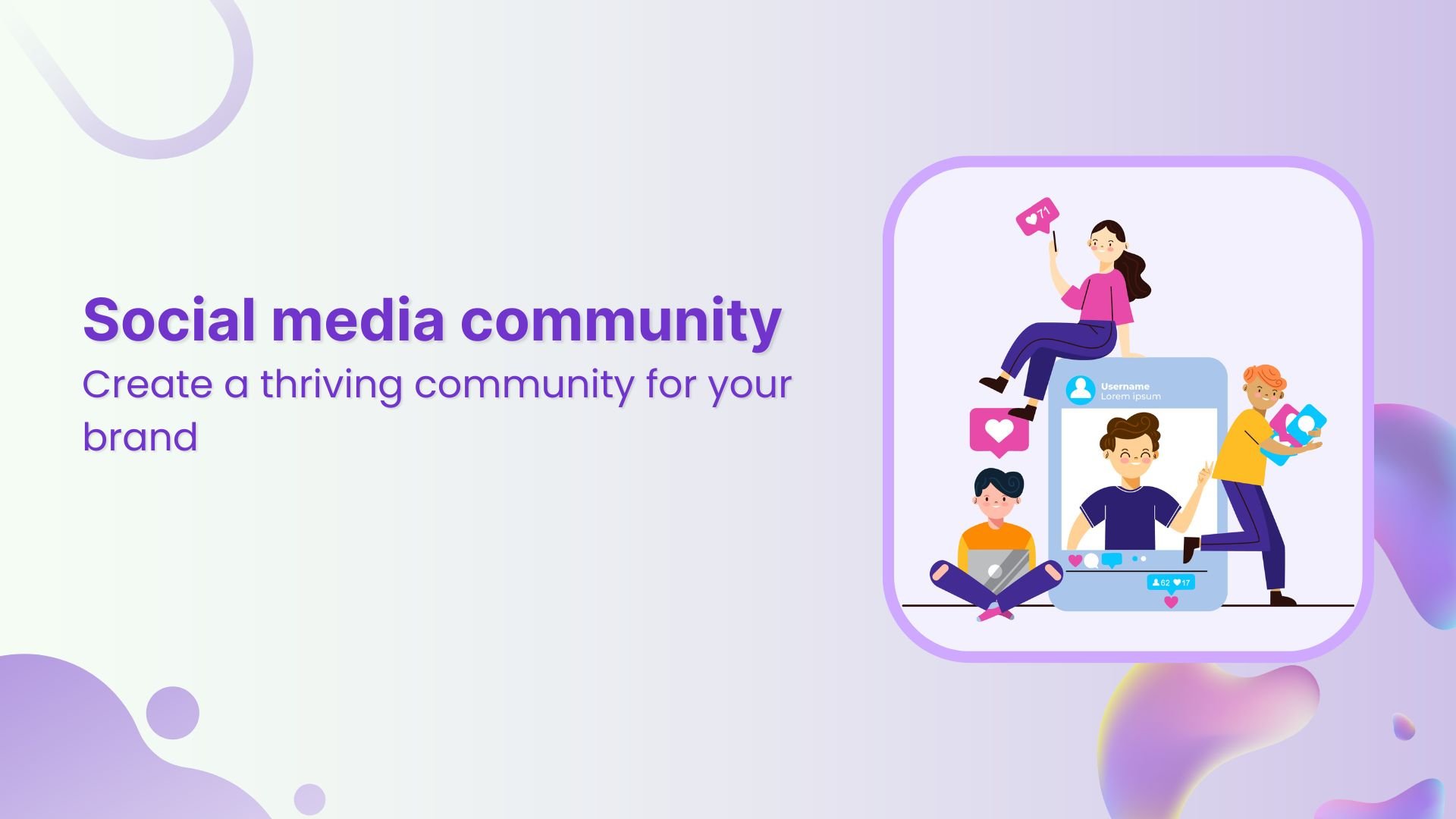Why you need a social media break: Signs, benefits, & how-to
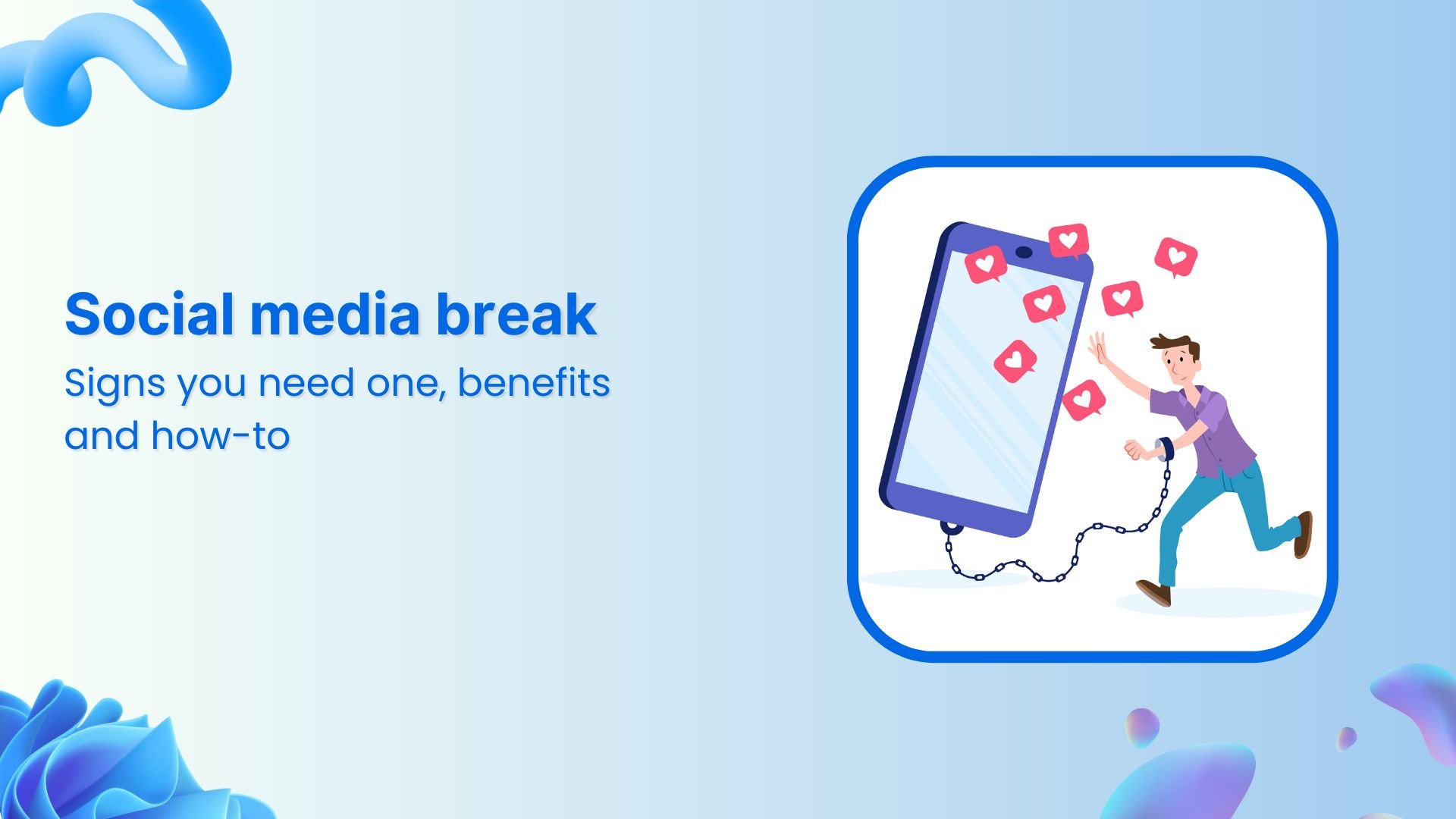
Terms like “chronically online,” “FOMO,” and “doomscrolling” are not just any modern buzzwords. Instead, they have become the reality of a lot of people nowadays who are addicted to social media platforms, increasing the importance of a social media break.
While social media sites offer incredible opportunities for connection, learning, and entertainment, they can also become sources of stress, comparison, and digital overwhelm. So, if you have ever felt drained after a social media session, you might need a strategic social media break.
This comprehensive guide explores why taking breaks from social media isn’t just beneficial but often necessary for our mental health and overall well-being.
What is a social media break?
A social media break is a deliberate period where you temporarily reduce or completely stop using social media platforms. This isn’t about permanently deleting your accounts or swearing off digital connection forever. It’s about creating intentional space between yourself and the constant stream of posts, notifications, and digital interactions.
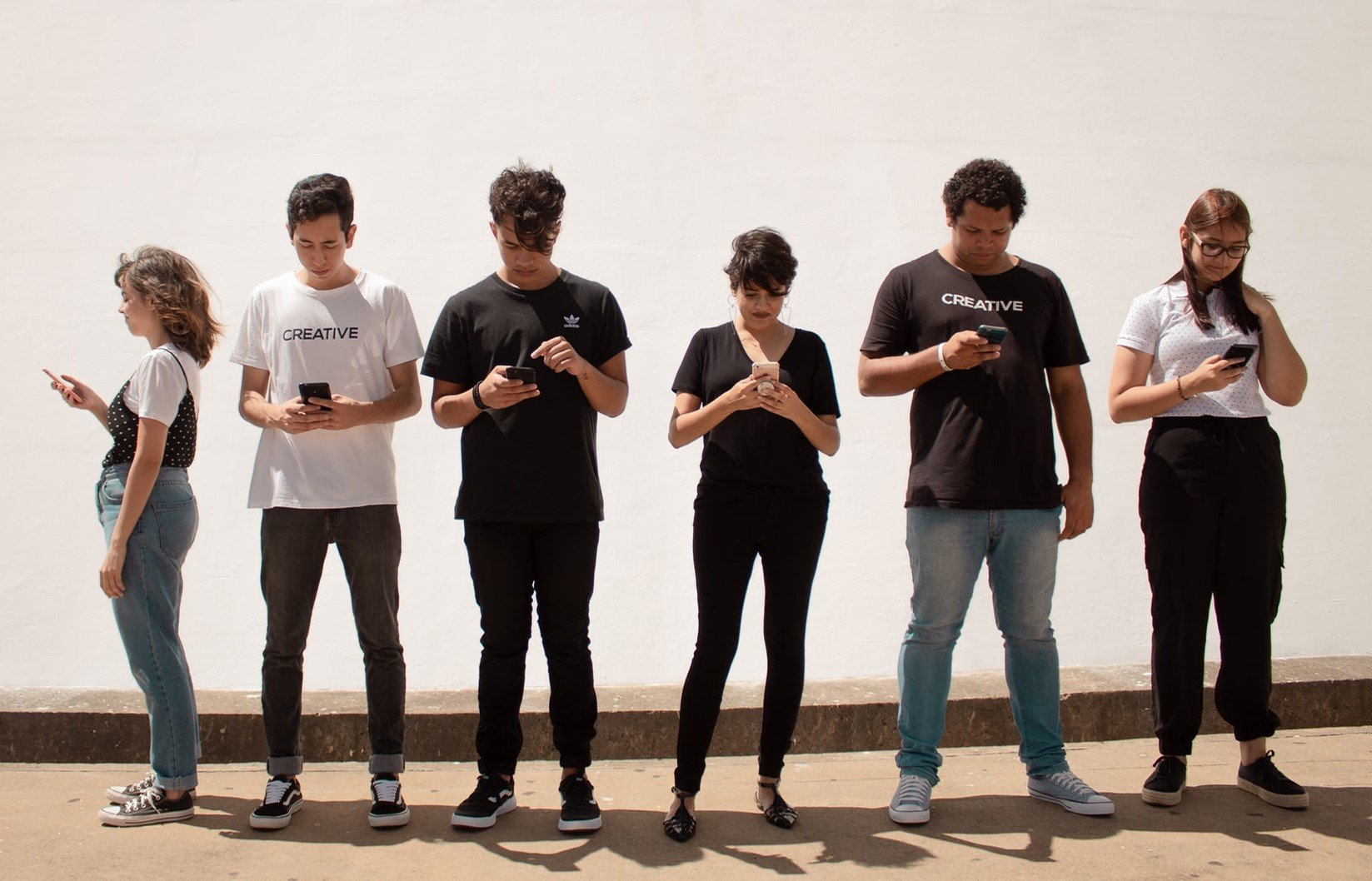
Social media breaks can vary significantly in duration and scope:
- Micro-breaks: 24-48 hours away from platforms
- Short breaks: One week to one month
- Extended breaks: Several months to a year
- Platform-specific breaks: Stepping away from particular apps while maintaining others
- Scheduled breaks: Regular intervals (like weekends or evenings) without social media
The key distinction is intentionality. Unlike accidentally forgetting to check your phone, a social media break involves conscious decision-making about when, how, and why you’re stepping away.
Why take a social media break?
Now that you know exactly what a social media break is, you might be wondering why you need it in the first place.
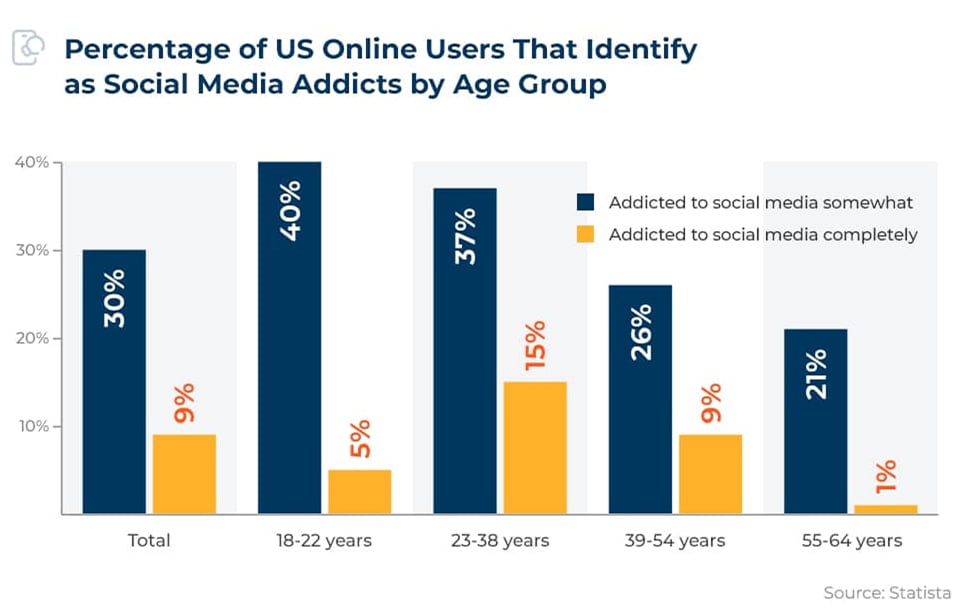
Well, there are plenty of reasons why taking a break from social media is important:
Understanding social media burnout
Social media burnout manifests as emotional, physical, and mental exhaustion caused by prolonged exposure to digital platforms. Unlike general fatigue, this specific type of burnout stems from information overload, social comparison, and the pressure to maintain an online presence.
Pennsylvania University research found that limiting social media use to 30 minutes per day for just one week led to significant reductions in loneliness and depression. This suggests that even brief breaks can have profound impacts on our psychological well-being.
Common symptoms of social media burnout include:
- Feeling anxious when unable to check platforms
- Experiencing mood changes after social media use
- Physical symptoms like eye strain or “text neck”
- Difficulty concentrating on offline activities
- Sleep disruption from late-night scrolling
Signs you need a social media break
Recognizing when you need a break is crucial for maintaining healthy digital habits. Here are key indicators:
Emotional signs:
- Feeling inadequate after viewing others’ posts
- Experiencing anger or frustration while browsing
- Mood swings correlating with online interactions
- Increased anxiety when notifications are delayed
Behavioral signs:
- Checking platforms immediately upon waking
- Interrupting real-world activities to post or respond
- Losing track of time while scrolling
- Feeling compelled to document every experience
Physical signs:
- Eye strain or headaches from screen time
- Poor posture from device use
- Disrupted sleep patterns
- Reduced physical activity
Social signs:
- Preferring online interactions over face-to-face conversations
- Feeling disconnected from people physically present
- Comparing your real life to others’ curated online presence
Benefits of taking a break from social media
The advantages of a social media break extend far beyond simply feeling less overwhelmed. The following table summarizes why taking a break from social media is good for you:
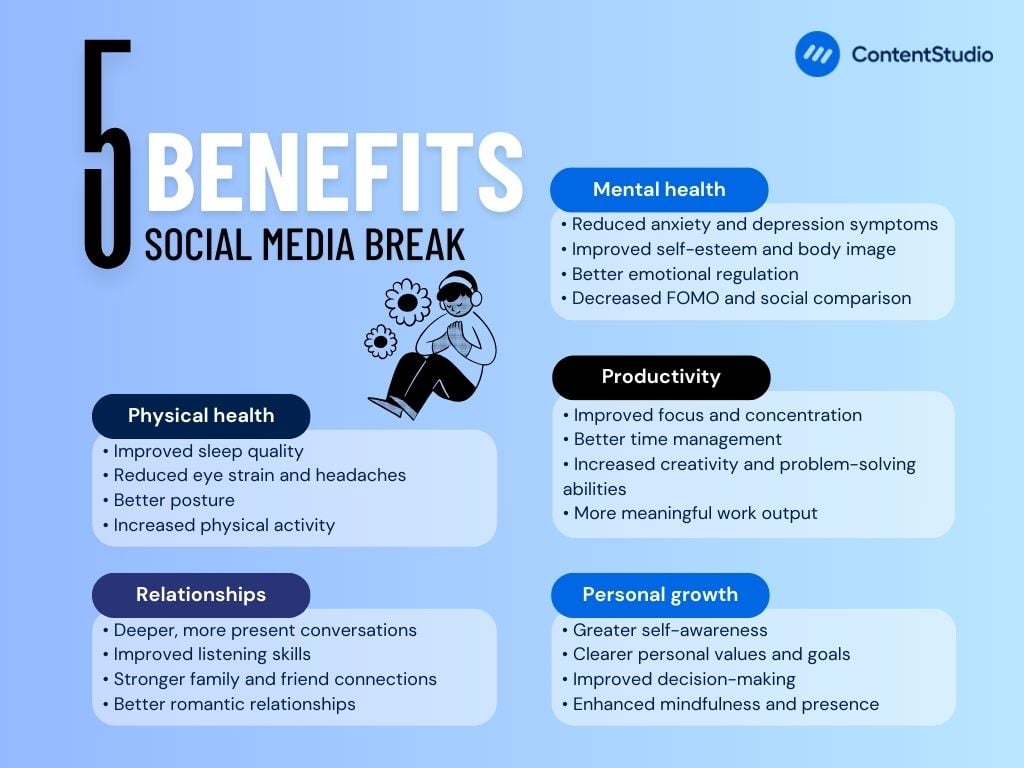
How to take a break from social media?
Taking a social media break can prove to be difficult for a lot of people, especially if they are used to spending a lot of hours on such platforms. The following are some techniques you can use to be successful in this effort:
Set a limit
Rather than going cold turkey, consider gradually reducing your social media usage. This approach is often more sustainable and less likely to result in immediate relapse.
Start with time boundaries:
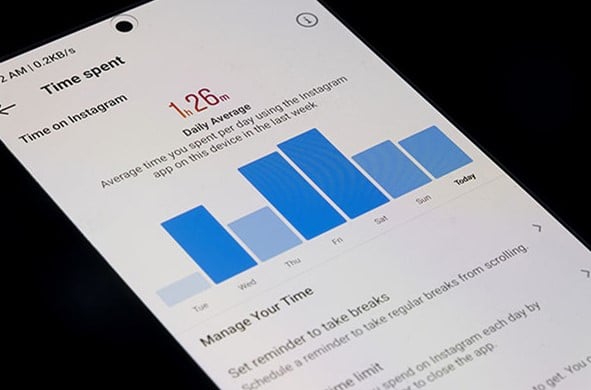
- Use built-in screen time controls on your device
- Set specific “social media hours” (e.g., 7-8 PM only)
- Implement the “20-20-20 rule”: Every 20 minutes, look at something 20 feet away for 20 seconds
Create usage rules:
- No social media before breakfast
- No scrolling in bed
- One platform per day
- Only check notifications at designated times
Delete the apps
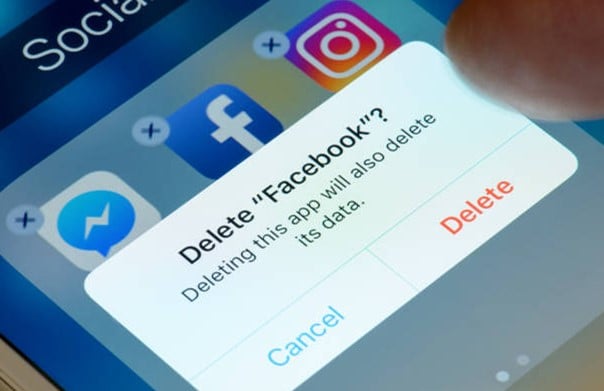
Removing apps from your phone creates necessary friction between you and mindless scrolling. This doesn’t mean permanently deleting your accounts, but simply making access less convenient.
For example, you can:
- Start with your most problematic platform
- Move remaining apps to a folder buried in your phone
- Log out of platforms on all devices
- Use website versions instead of apps (they’re typically less engaging)
Take a break from specific platforms
Not all social media affects you equally. Consider taking breaks from platforms that trigger negative emotions while maintaining those that bring genuine value.
Some of the questions you should consider to take a break from specific social media platforms are:
- Which platforms make you feel worse about yourself?
- Where do you lose the most time mindlessly scrolling?
- Which platforms align with your current goals and values?
- What platforms feel more like obligations than enjoyment?
Turn off notifications
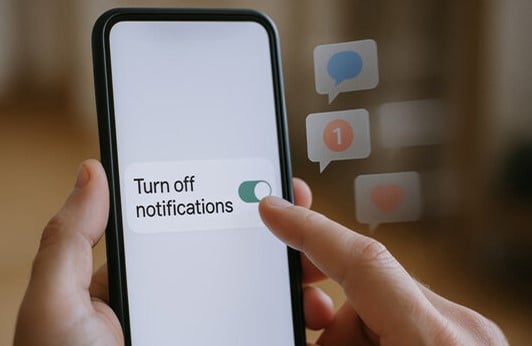
Notifications create artificial urgency and interrupt your natural flow throughout the day. Disabling them helps break the urge to respond instantly to constant digital stimulation. So, you should:
- Turn off all non-essential push notifications
- Use “Do Not Disturb” mode during focused work times
- Check messages at designated intervals rather than immediately
- Remove social media apps from your lock screen
Also read: How to turn off Story notifications on Instagram?
Set up guardrails
Create environmental changes that support your break goals. These guardrails include:
Physical guardrails:
- Charge your phone outside the bedroom
- Use a traditional alarm clock instead of your phone
- Create phone-free zones in your home
- Keep devices in another room during meals
Digital guardrails:
- Use website blockers during certain hours
- Enable grayscale mode to make your phone less appealing
- Set up automatic responses explaining your limited availability
- Use apps that track and limit your usage
Intentionally occupy your time with other things
The key to a successful social media break is filling the time vacuum with meaningful activities. Without replacement activities, you’re likely to default back to scrolling. Some of the productive alternatives to social media are:
- Read books you’ve been meaning to finish
- Learn a new skill or hobby
- Exercise or take up a sport
- Practice meditation or mindfulness
- Spend time in nature
- Cook new recipes
- Connect with friends through calls or in-person meetings
How to take a social media break as a content creator?
The tips and strategies discussed in the previous section are for general users to take a social media break. However, the real challenge is for content creators, as social media platforms are often tied to income and professional identity.
Here are some strategies that can help content creators take a break from social media:
Plan your break
Strategic planning ensures your break doesn’t negatively impact your business or audience relationships. Make sure you:
- Analyze your content performance to identify optimal posting times
- Create a content calendar for your absence
- Set up analytics tracking to monitor engagement during your break
- Prepare your team or collaborators for increased responsibilities
- Plan your return strategy
Social Media Analytics
Fine-tune your social media strategy for success with in-depth analytics and white-labeled reports.
Get Started for FREE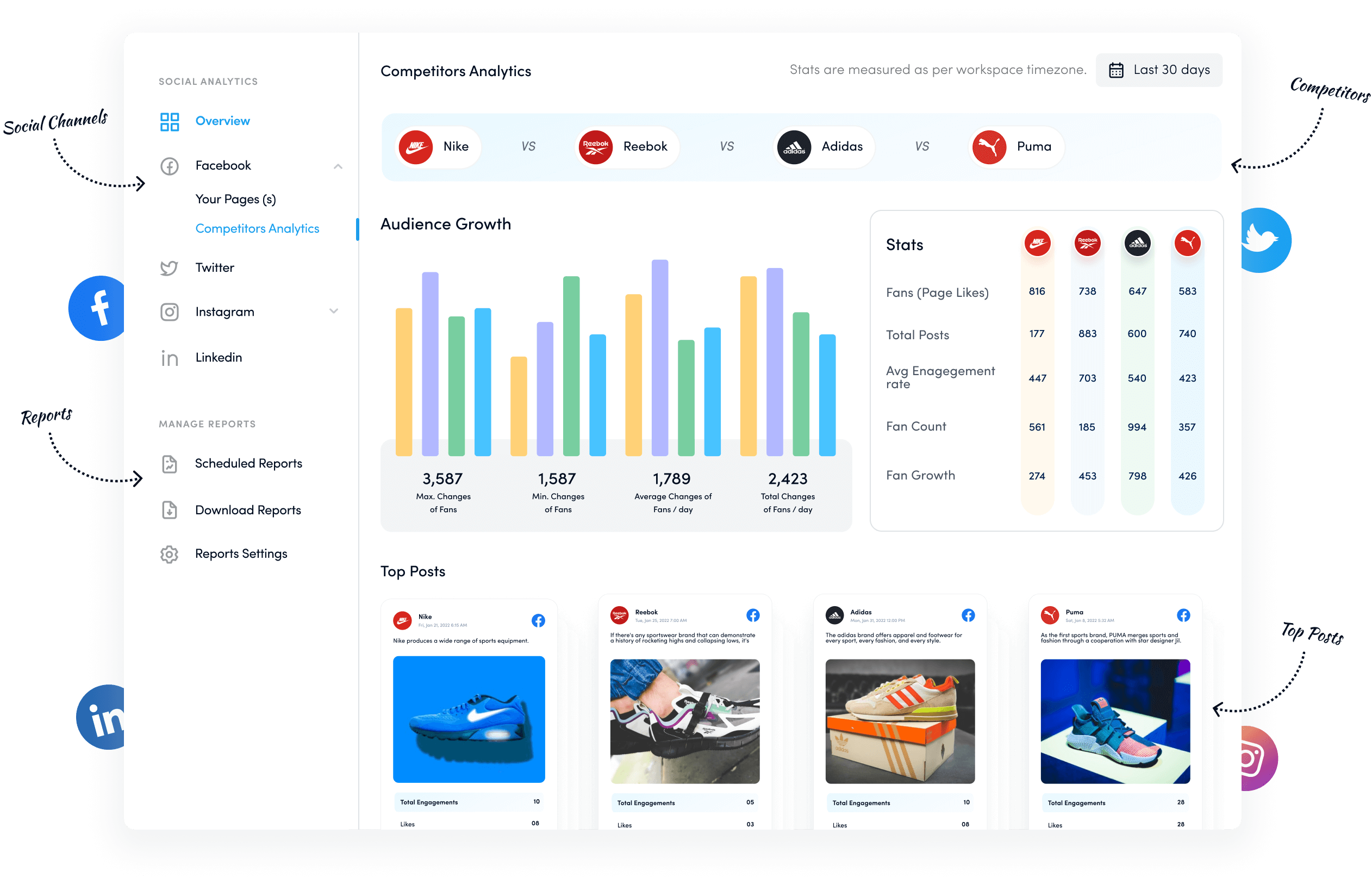
Let your audience know
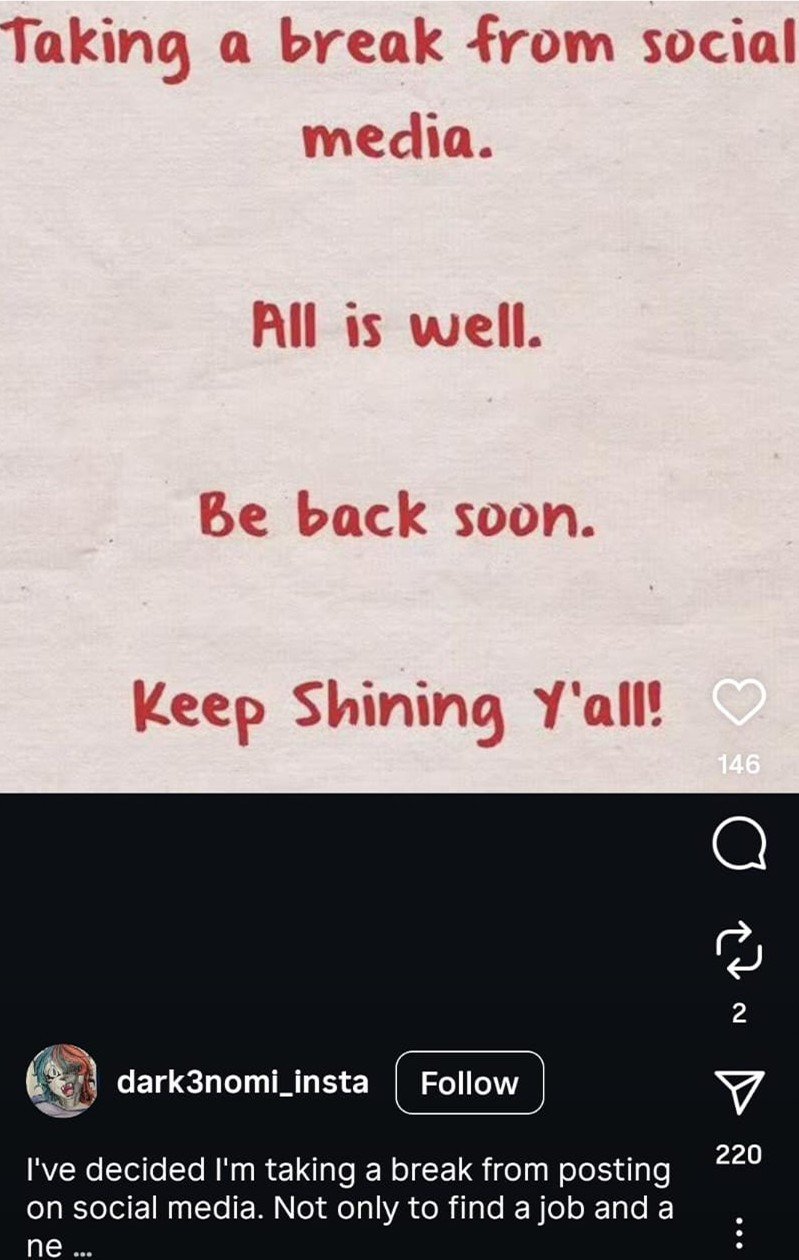
Transparency builds trust and sets appropriate expectations with your followers. So, you should let your audience know that you are taking breaks from social media.
- Share your reasons for taking a break (without oversharing)
- Specify the duration of your absence
- Provide alternative ways to contact you if necessary
- Express gratitude for your audience’s understanding
- Share what you hope to accomplish during your break
Sample announcement:
“I’m taking a two-week social media break to recharge and focus on some exciting projects behind the scenes. I’ll be back on [date] with fresh content and renewed energy. Thank you for understanding. Sometimes stepping back helps us come back stronger!”
Schedule content while you’re away
Use scheduling tools to maintain some level of presence while you’re taking a personal break from active engagement. This approach allows you to step back from daily posting stress while keeping your accounts active.
Moreover, you should prepare evergreen content in advance that doesn’t require real-time engagement or responses. This might include educational posts, inspirational quotes, or repurposed older content that’s still relevant.
Consider sharing user-generated content or testimonials during your break. This provides value to your audience while requiring minimal effort from you during your time away.
Use a social media management tool like ContentStudio.io to schedule posts across multiple platforms.
Decide your activities
Use your break time strategically to benefit both your personal well-being and your content creation business.
Some of the professional development goals you can achieve during social media breaks are:
- Learn new skills relevant to your niche
- Plan future content series
- Research industry trends
- Network with other creators offline
- Work on long-term projects without distraction
How to get the most out of your social media break?
Maximizing your break’s benefits requires intentional practices and mindful attention to the experience.
Reflection practices:
- Keep a journal throughout your break
- Note changes in mood, productivity, and relationships
- Identify what you miss and what you don’t
- Reflect on your relationship with social media
- Set intentions for your return
Mindfulness techniques:
- Practice being present in offline moments
- Notice urges to check social media without acting on them
- Observe how your attention span changes over time
- Pay attention to real-world interactions and experiences
Goal setting:
- Use the mental clarity to set personal and professional goals
- Identify values that matter most to you
- Plan meaningful projects or experiences
- Consider lifestyle changes you want to make
7 things to do during your social media break
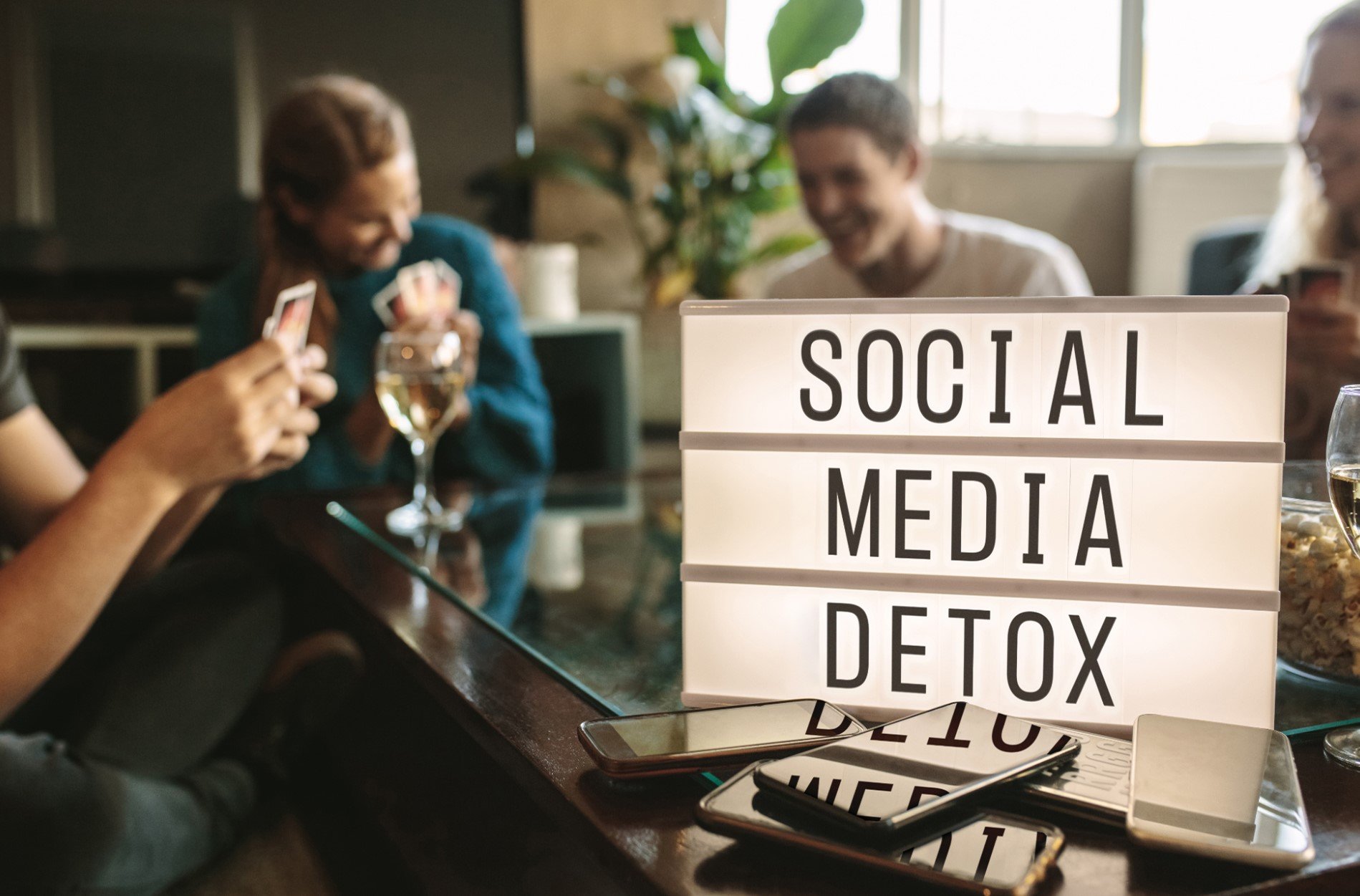
Here are some great things you can do while taking breaks from social media:
- Read physical books: Rediscover the joy of deep reading without digital distractions
- Practice a creative hobby: Try painting, writing, music, or crafts that engage your hands and mind
- Exercise regularly: Use the extra time for physical fitness and outdoor activities
- Connect face-to-face: Schedule coffee dates, phone calls, or visits with friends and family
- Learn something new: Take an online course, learn a language, or develop a professional skill
- Declutter your space: Organize your home, workspace, or digital files
- Practice mindfulness: Try meditation, yoga, or simply spending quiet time in reflection
What to do after your social media break?
Returning to social media after a break requires careful consideration to avoid immediately falling back into unhealthy patterns. The transition back should be gradual and intentional, incorporating the insights and habits you developed during your time offline.
1. Start slowly: Start by evaluating how you feel about returning to social media. If you’re dreading it or feeling anxious about re-engaging, consider extending your break or returning more gradually. There’s no rule that says you have to return to your previous level of usage.
2. Implement boundaries: When you do return, implement new boundaries based on what you learned during your break. This might include specific time limits, unfollowing accounts that consistently make you feel bad, or changing your notification settings to be less intrusive.
3. Gradual re-entry: Consider a gradual re-entry rather than immediately resuming full usage. You might start with just one platform for a few days before adding others back into your routine. This approach helps you maintain awareness of how each platform affects your well-being.
4. Review: Review and curate your feeds before fully re-engaging. Unfollow accounts that consistently produce negative emotions, join groups that align with your values and interests, and be selective about the content you choose to consume.
Overall, you should establish new routines that incorporate the positive habits you developed during your break. If you started reading before bed instead of scrolling, maintain that habit. If you began taking morning walks, continue doing so rather than immediately returning to checking social media first thing in the morning.
Conclusion
Taking a social media break isn’t about rejecting technology but about creating a healthier, more intentional relationship with these powerful platforms. Whether you need a brief weekend detox or an extended hiatus, stepping away can provide clarity, restore mental energy, and help you reconnect with what truly matters.
The benefits extend far beyond the break itself. Many people find that their relationship with social media fundamentally shifts after taking intentional time away. You might discover that you need these platforms less than you thought, or you might return with clearer boundaries and purposes for your usage. For content creators a break can help them reconnect with the offline world and recharge without the constant strain of putting out content.
Remember, there’s no “right” way to take a social media break. The key is listening to your own needs, being honest about how these platforms affect your life, and taking action when you recognize the need for change.
FAQs
What is a social media break?
A social media break is a temporary period where you deliberately avoid or limit your use of social media platforms. This can range from a few hours to several months and can involve complete disconnection from all platforms or selective breaks from specific ones that are causing stress or taking up too much time.
How long should a social media break be?
The length of a social media break depends on your personal needs and circumstances. A weekend break can provide quick relief from social media stress, while longer breaks of one to four weeks allow for more significant habit changes and mental health improvements.
Are social media breaks healthy?
Yes, social media breaks can be very healthy for most people. Research shows they can reduce anxiety and depression, improve sleep quality, increase productivity, and enhance real-world relationships.
Recommended for you
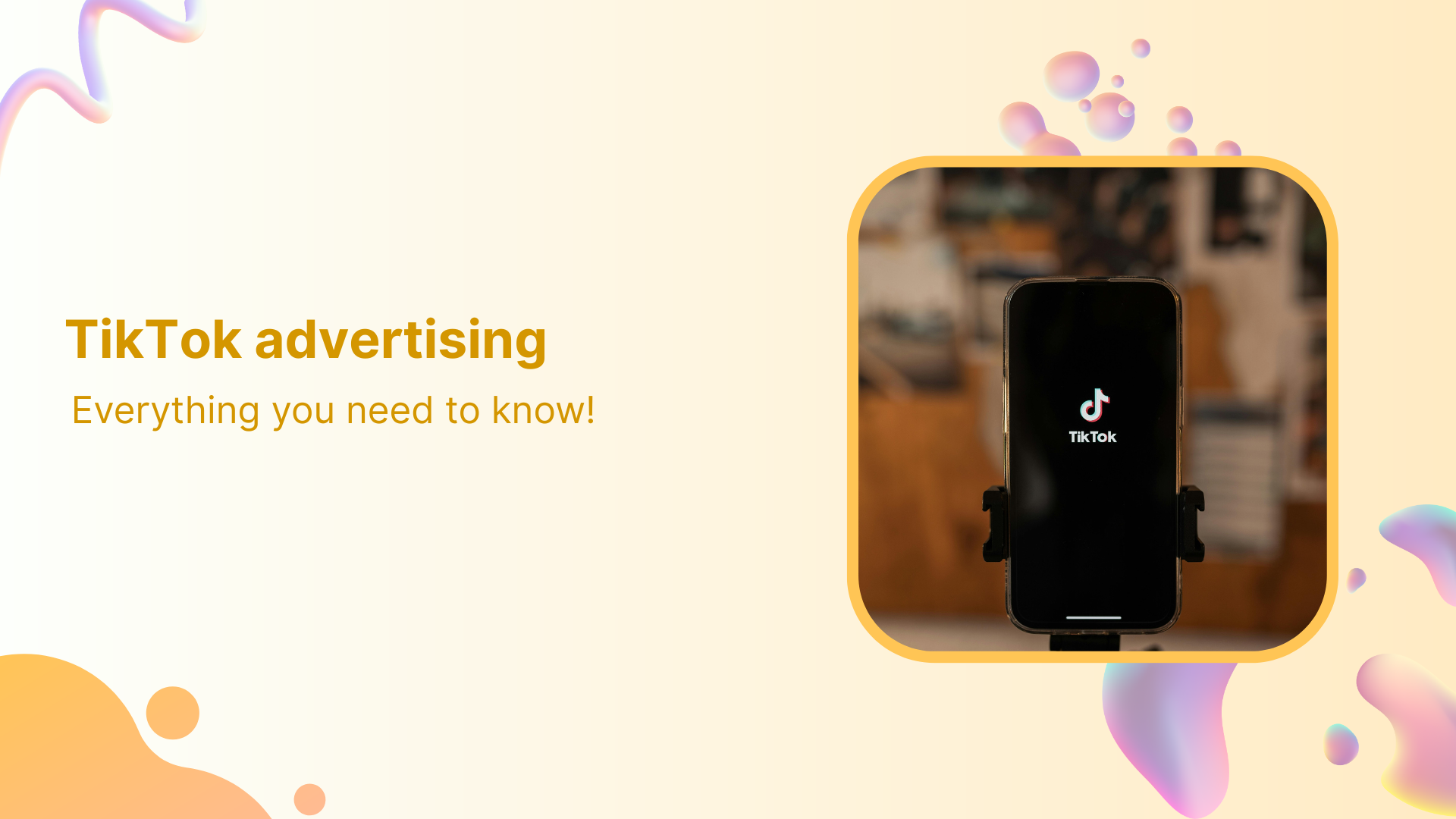
Is TikTok advertising worth it in 2025? Everything you need to know
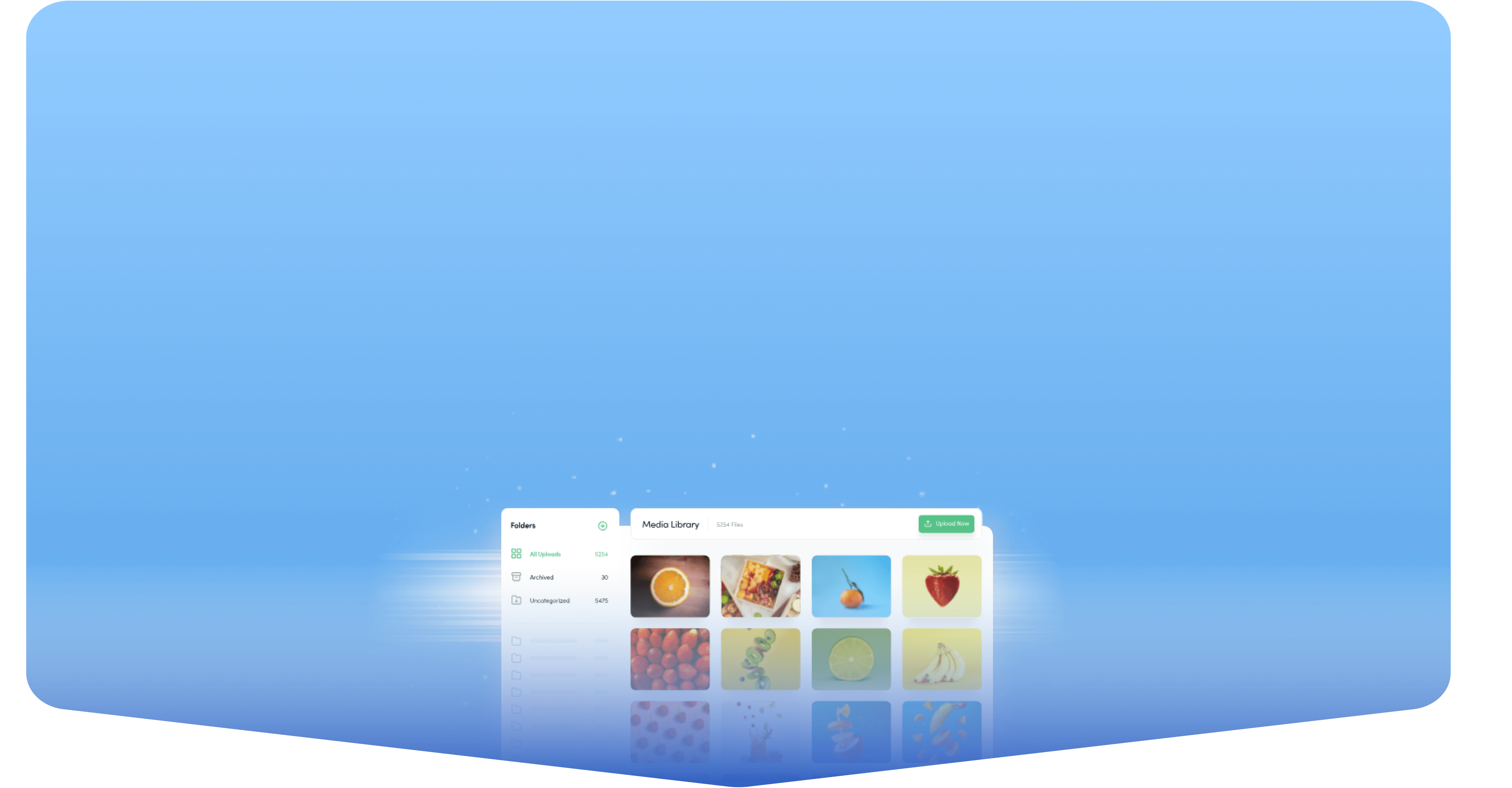
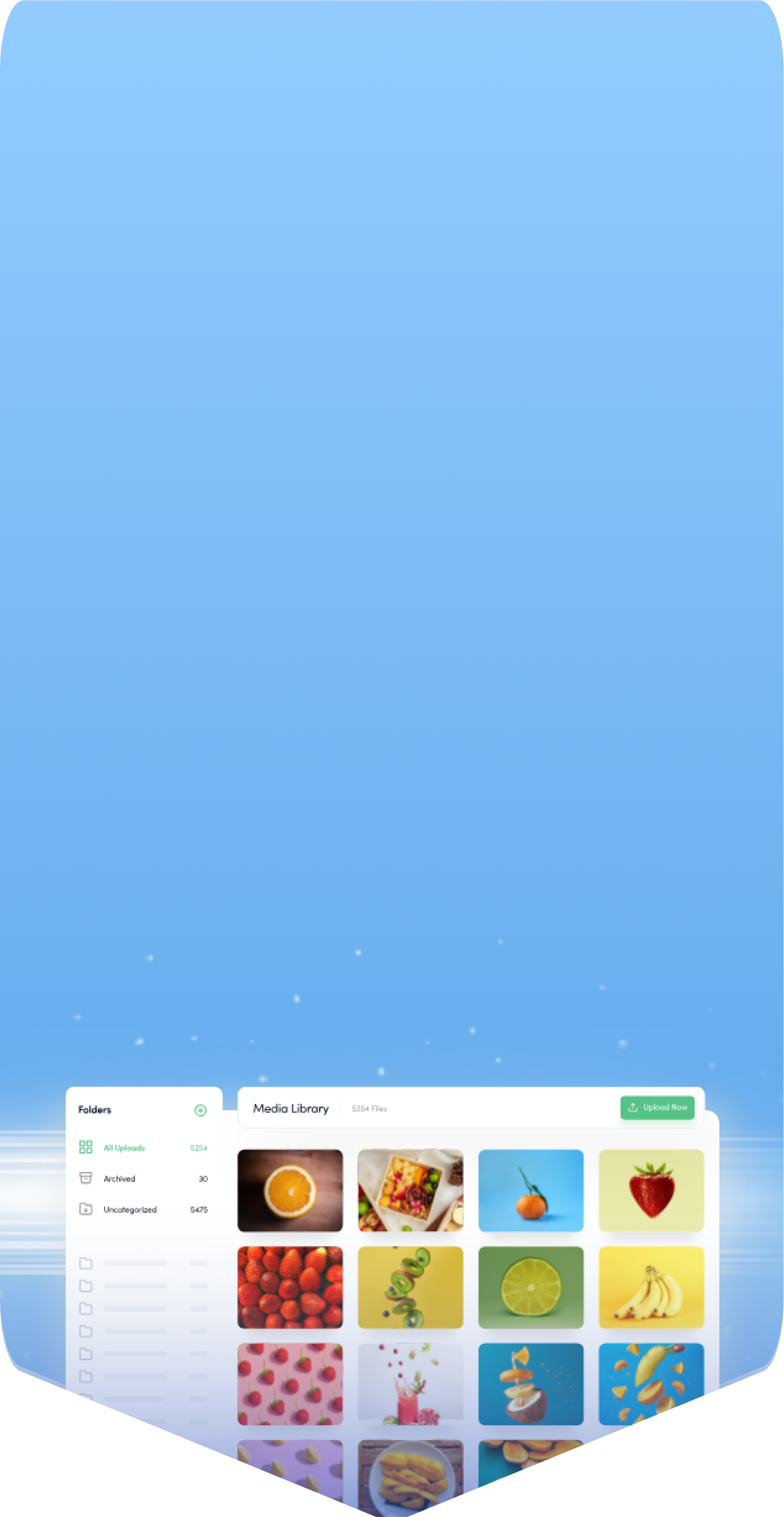
Powerful social media management software
14-day free trial - No credit card required.
